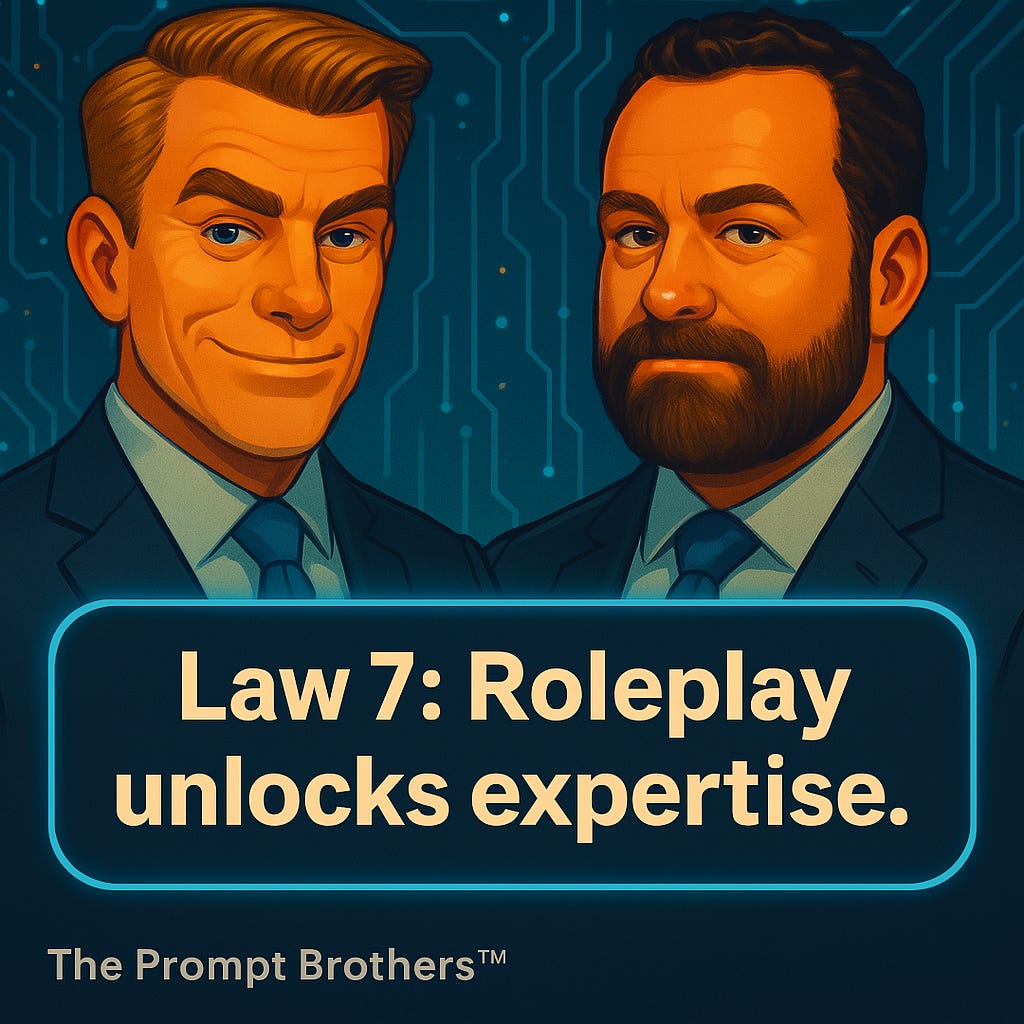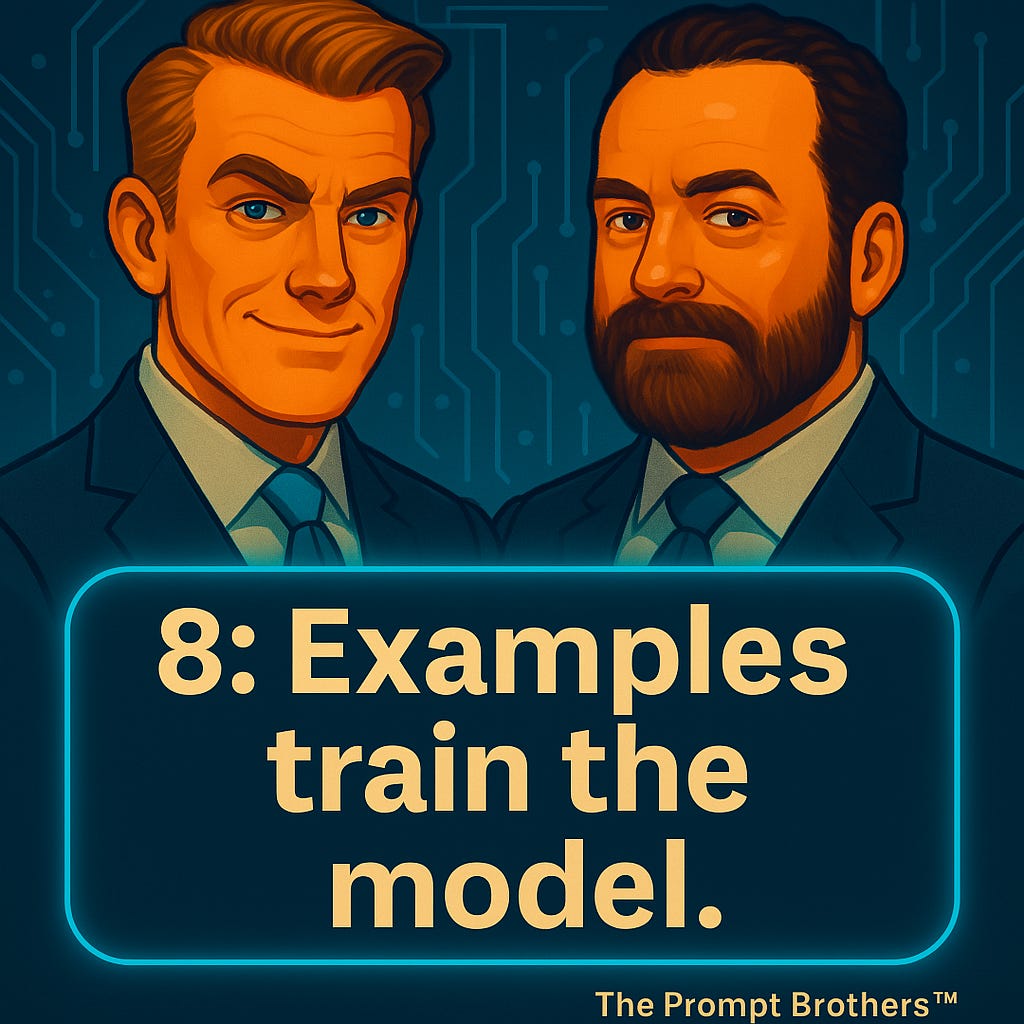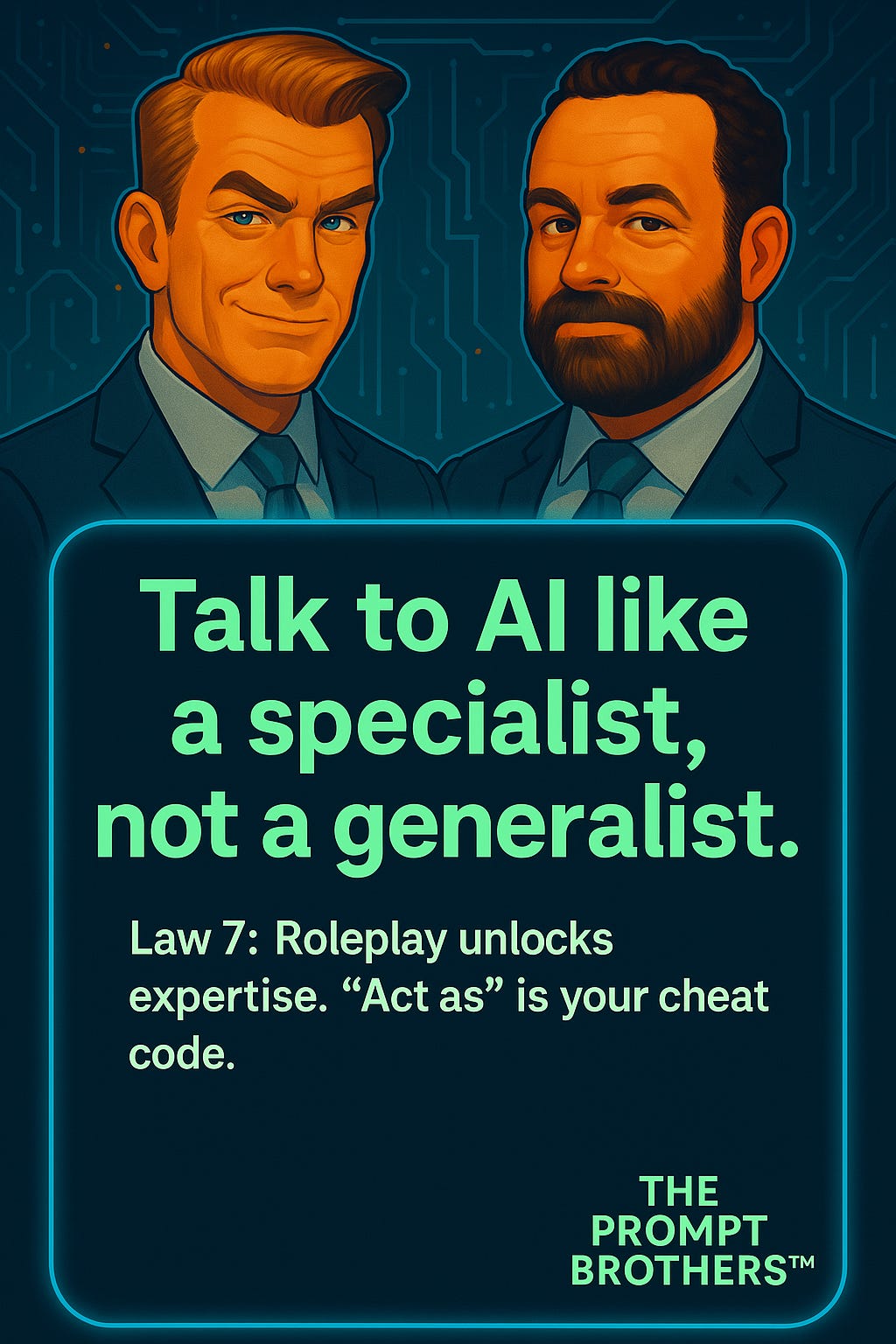The Prompt Brothers ™’ 8-Week Sprint is designed to rewire your thinking about prompting.
Each week:
🎯 1 core principle
⚔️ 1 real-world challenge
🚫 No fluff. No gimmicks. No upsells.
👋 Welcome back.
Week 1 showed you how to stop sounding like a résumé generator. This week, we shift from what to who.
Here’s the part people get wrong:
They ask it to “write something good” and hope it just knows what that means.
It’s not magic. It’s behavioral compression.
Here’s the fix: Stop describing the output. Start defining the expert.
💡 The Prompt Brothers™ Laws of AI Precision 💡
Your prompt safety net—don’t skip it.
Clarity over cleverness. Your input is not a riddle.
AI is a prediction engine, not a mind reader. Feed it structure.
Vague in = vague out. Always.
Context is leverage. Attach anything that sharpens the ask.
Constraints are freedom. Define what matters—and what doesn’t.
Outcome beats output. Ask for results, not rambling.
Roleplay unlocks expertise. “Act as” is your cheat code.
Examples train the model. Show before you tell.
Break big asks into steps. The chain of thought wins.
AI doesn’t fact-check itself. You have to. Always keep a human in the loop.
🧠 WEEK TWO || The Persona Pattern
You don’t always know how something should sound.
But you almost always know who you’d trust to say it.
That’s what makes the Persona Pattern so powerful. You’re not just prompting for text—you’re activating behavior, mindset, tone, and context with a single line:
Act as a [role]. Respond as they would.
It’s fast. It’s accurate. And it’s information-dense.
👶 8th-Grade Explainer
If you had a weird tax question, you'd call your accountant.
If you had a regulatory concern, you'd call your lawyer.
The Persona Pattern tells AI: “You’re that expert now. Think like them.”
It works even if you don’t know how that expert phrases a memo. AI does—because it’s seen enough to simulate their behavior.
🧪 Examples in Action
The Persona Pattern gives professionals access to specialized insight on demand—without pulling in another department or paying a consultant. Just name the role, and let the model simulate the mindset.
Example 1: Risk Summary from a CFO
Prompt:
“Act as a Chief Financial Officer. Review our Q3 earnings [attach .xls]. Based on this, summarize the top three financial risks of expanding into a new international market. Use a professional, concise tone suitable for a board briefing.”
Output:
Margin Compression: Projected cost of goods sold in new markets is 17–22% higher than domestic levels, driven by local supplier volatility and logistics constraints.
FX Exposure: Revenue forecasts are vulnerable to currency fluctuation, particularly in regions with unstable exchange rates or inflation risk.
Compliance Overhead: Estimated onboarding time for local compliance is 3–5x longer than existing operations, increasing regulatory burden and delaying market entry.
💡 Why this works:
You didn’t need to write the memo. You just cast the role—and the model stepped into it.
Example 2: Legal Review from General Counsel
Prompt:
“Act as General Counsel. Review the following partnership agreement draft [attach PDF]. Identify three potential legal risks and suggest one clause that should be revised to mitigate exposure.”
Output:
IP Ambiguity: Clause 4.2 does not clearly define ownership of co-developed assets, which could result in future IP disputes.
Termination Terms: The agreement lacks specificity around termination for cause, creating potential exposure if the partner underperforms.
Jurisdiction Risk: Current arbitration clause defaults to a non-neutral jurisdiction, which may disadvantage us in the event of conflict.
🔄 Suggested Revision:
Replace “disputes shall be governed by the laws of [Partner HQ]” with “disputes shall be resolved via arbitration in a mutually agreed neutral venue.”
💡 Why this works:
You got a lawyer's point of view without writing like one. The model adapted instantly to the persona you assigned.
Example 3: Risk Framing from Medical Affairs
Prompt:
“Act as a Director of Medical Affairs at a global pharma company. Review this Phase 2 clinical trial summary [attach PDF]. Identify two patient safety concerns that should be flagged before publication. Respond in a clear, regulatory-aware tone.”
Output:
Adverse Event Reporting: Incidence of Grade 3 fatigue in Arm B (12%) is higher than expected. Without clarification, this could raise safety profile concerns among regulators.
Data Stratification Gaps: Age-related response variability is unaddressed. Stratified subgroup analysis is needed before public release to avoid misinterpretation.
💡 Why this works:
This isn’t just spell-checking a PDF. It’s simulating a high-stakes internal review—from a role that knows what to flag.
🎯 Action Challenge
Pick a real deliverable you’re working on this week—a client memo, a summary, a response, anything.
Now prompt it using the Persona Pattern.
Format:
“Act as [persona]. Review/respond to [input] from that point of view.”
✅ Run your original prompt.
✅ Then run your Persona Pattern prompt.
📤 Share what changed in the comments!
🗺️ Sprint Map: Where We’re Going
This is your 8-week transformation—from AI dabbler to structured prompt strategist:
Clarity = Impact
If your AI sounds generic, it’s your fault.The Persona Pattern
Make AI work like a specialist.Examples Train the Model
Show before you tell.Constraints Create Freedom
Guardrails that drive better results.Break It Down to Build It Right
Chain of thought = power prompts.Outcome > Output
Ask for results, not rambling.Act Like You Own the Place
Advanced roleplay techniques for influence and insight.Precision at Scale
Reuse, systematize, and scale with confidence.
🧭 Up Next
📍 Week 3: Examples Train the Model
You’ve been telling AI what you want. Next week, you’ll learn how to show it once—and let the model follow the pattern. Drops Wednesday.
You're not just getting better at prompting.
You're getting better at thinking.
—The Prompt Brothers™ | Brian & Dan
🫵 Give good prompt. 👍 Get better AI.
questions? brismith@gmail.com





